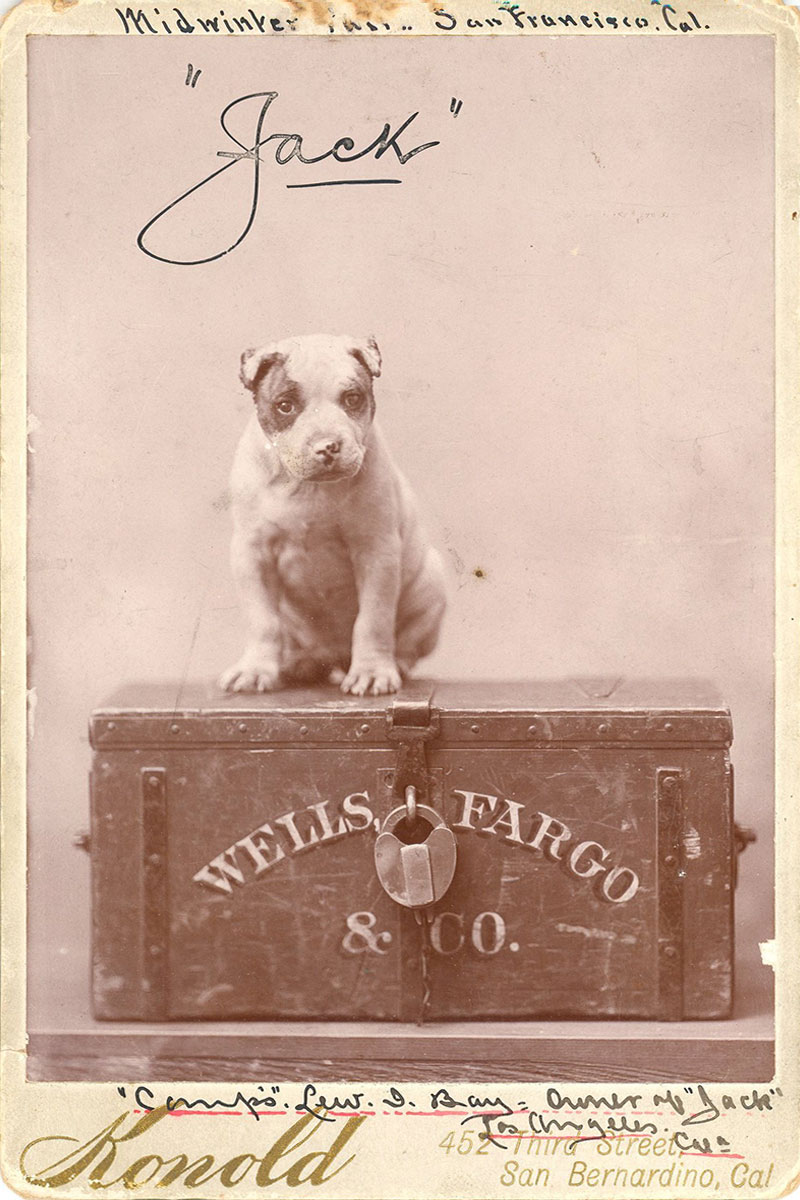The faithful guard dogs who kept us safe

From Wells Fargo’s earliest days, dogs were the devoted companions and protectors of many employees. In the mid-1850s, agent John Q. Jackson shipped several hundred pounds of gold each month from Wells Fargo’s office in Auburn, California, to various locations. The responsibility and risk of handling large amounts of gold weighed heavily on Jackson’s mind, but the enterprising Wells Fargo agent quickly found a solution: A large dog joined the office staff. In a letter to his family back in Virginia, Jackson described the 128-pound canine as “a friend, counselor, and safeguard” and “a very intelligent and noble fellow devoted to his business who takes as much interest in the office, seemingly, as anyone connected with the establishment.”
Tiger
Not far from Jackson’s office, agent Thomas Hotchkiss owned a large dog named Tiger, who faithfully guarded Wells Fargo’s office safe in Iowa Hill, California. On February 12, 1857, a fire burned through the town, and although Hotchkiss twice pulled “Old Tig” from the building, the loyal dog returned to his post and passed away. The local newspaper, Placer Herald, mourned him as a faithful guard, “ever true to the duties of his master.”
The steadfast loyalty of Tig and many other dogs endeared them to workers everywhere, and their contributions became a part of Wells Fargo’s history. In fact, an alert dog guarding a safe or treasure box became a universal symbol of security throughout the express transportation business, utilized by Wells Fargo and several of its competitors. Dogs sometimes even rode as “helpers” aboard wagons or trains and became beloved mascots of many Wells Fargo offices.
Several other dogs are remembered for their contributions to Wells Fargo.
Boozer

Boozer wandered into the Wells Fargo Polk Street Depot in Chicago as a puppy, suffering from a broken leg. After being nursed back to health by Wells Fargo employees, Boozer became a celebrity. The terrier accompanied the company’s messengers on trains from coast to coast in the 1910s, but seemed most at home with his human friends in the Windy City.
Bum
Wells Fargo used to transport dogs for customers. One adventurous little Scottish terrier started his career with Wells Fargo after escaping from his crate during shipment. He reappeared in a few weeks, but his owner no longer wanted him, so employees adopted him and named him Bum. He continued his freewheeling lifestyle, traveling by train to company offices throughout the U.S. and Mexico in the 1910s.
Teddy

Teddy, a stray poodle, helped foil a burglary in progress at the Wells Fargo office in San Mateo, California, in 1916. As a reward, he was adopted as an official Wells Fargo employee — with a new collar and license to prove it.
Jack

The most famous Wells Fargo dog of all was named Jack, who still appears on Wells Fargo products and internal videos. At San Francisco’s Midwinter Fair in 1894, Wells Fargo employee Lew Bay posed his puppy on a Wells Fargo treasure box.
This portrait of Jack became a popular fair souvenir and a reminder of all of Wells Fargo’s faithful companion canines. Perched atop a Wells Fargo treasure box, Jack reminded people of Wells Fargo’s vigilance in attending to customer security.





